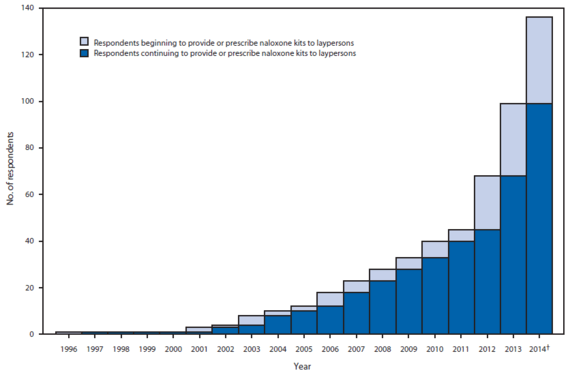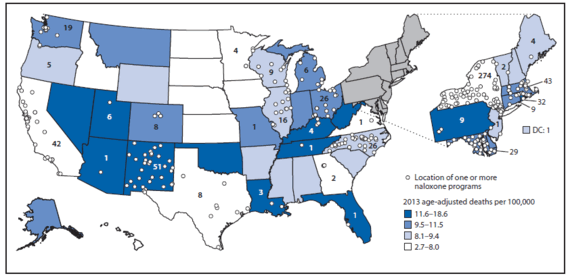This week the CDC released its long-awaited report on overdose prevention programs providing naloxone to laypersons. The detailed report, which surveyed 136 naloxone distribution programs nationwide, confirms some of what overdose prevention advocates already knew, but also holds a few surprises. Here are the top three highlights:
1.In the past four years alone, the number of organizations that distribute naloxone has more than doubled - From 1996 to 2010, the date of the first naloxone distribution survey, 48 organizations had trained approximately 53,000 laypeople to reverse a drug overdose using naloxone, resulting in over 10,000 reversals. But in 2014, when the most recent survey took place, 136 organizations were providing naloxone to over 150,000 laypeople, resulting in over 26,000 reported reversals. In just four years the number of organizations providing naloxone increased by 183%, the number of laypeople trained on how to use naloxone and provided a kit went up by 187% and the number of reported reversals increased by 160%.
"We've seen a massive scale up in the last couple years," says Eliza Wheeler, an author on the report. "The last survey we did [in 2010] showed naloxone was mostly distributed through syringe exchange programs and community based organizations, but this time around we heard back from Veterans Administration programs, substance use programs, and even pharmacies."
2.The overwhelming majority of successful overdose reversals were carried out by people who actively use drugs and their loved ones - Until this report there were no official numbers on which naloxone recipients were most effective at reversing a drug overdose. Now we have data to confirm what most naloxone distribution programs already knew. 82.8% of the reported reversals were done by people who use drugs and 9.6% by family and friends of a user. Service providers came in at a distant 0.2%.
"In order for naloxone to be most effective, we need to get it into the hands of people who are most likely to be on the scene of an overdose," says Dr. Stephen Jones, also a researcher and author of the report. "An opioid overdose is a life-threatening medical emergency. If laypeople have naloxone, they can start the process of reviving the person before paramedics or law enforcement come through the door."
3.Most naloxone overdose reversals involved heroin - Heroin was involved in 81.6% of reported reversals, while prescription opioids were involved in 14.1%. Overall, heroin accounts for 19% of drug overdose deaths, while prescription opioids account for 37%. This demonstrates that overdose prevention programs are most successful at reaching heroin users, but indicates potential gaps in out-reach to people who overdose on prescription medications, who make up the majority of those who die from opiate drug overdose.
"We need newer and better methods to get naloxone into the hands of people who use prescription opioids," says Dr. Jones.
"The data is really encouraging," says Wheeler. "But it also indicates that there are huge gaps around the country, states where there are few or no distribution programs. We also heard back from many existing programs that they struggle with funding and recent price increases for naloxone. I think the take-away here is that these programs are saving many lives but are often under-resourced and that needs to change."


